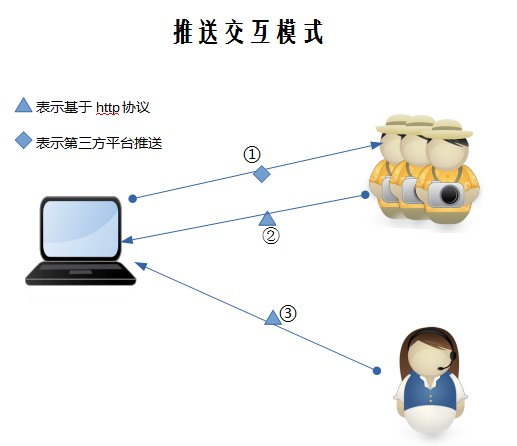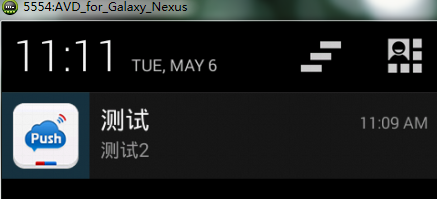项目ITP(三) 玩玩 服务端 到 app端
前言
系列文章:[传送门]
泡泡脚,写写博客,规律生活,睡个好觉,待会看会书。
正文
上面讲了二维码生成,及 手机端扫一扫,大家有兴趣去看看。
今天我们讲一下,百度云推送平台。
每天想着问题,问题只会慢慢的清晰。想着想着,慢慢模式就出来了。
模式

推送交互模式
①② 所指的是学生群体
③ 所指的是教师
③ :教师可以基于http 给服务器指示,提示服务器进行操作(push...等);或是直接在web端进行操作
① :学生群体接受 push,或是直接查看某些通知,或是直接查看富文本,或是然后点击进行(③步骤)
② : 学生基于http 从服务器拉去资料
##ps:大家有好的点子 留言
百度云推送平台
百度云推送服务的相关信息,主要包括两部分:
1. 快速开发使用 Push 服务。
2. 更多 Push 服务的开发及使用功能。
Android端
- 注册百度账号,并成为百度开发者;
- 创建应用,获取 API Key 及 Secret Key,请参考查看应用密钥;
- 下载应用示例;
- 把示例(Android 项目)导入 Eclipse 工程;
- 运行示例应用;
- 登录管理控制台发送通知;
- 手机端接收通知。
详细资料:http://developer.baidu.com/wiki/index.php?title=docs/cplat/push/guide
下面是效果图:


#API Key : 应用标识,服务端绑定和推送都要用到
#Secret Key : 应用私钥,服务端推送时用到
#APP ID: 这个id ,就是个id ,虽然也有唯一行,暂时没什么用
#channel ID: 推送通道id,通常对应一台终端。同样的一个app ,装在手机A 和手机B上,channel id是不同的。
#user id : 应用的用户id,同一个用户,可以在不同的终端上拥有同一个app 。user id 和 channel id 配合使用
服务端
直接上代码吧
package sedion.jeffli.wmuitp.util.baidu; import com.baidu.yun.channel.auth.ChannelKeyPair; import com.baidu.yun.channel.client.BaiduChannelClient; import com.baidu.yun.channel.exception.ChannelClientException; import com.baidu.yun.channel.exception.ChannelServerException; import com.baidu.yun.channel.model.PushBroadcastMessageRequest; import com.baidu.yun.channel.model.PushBroadcastMessageResponse; import com.baidu.yun.channel.model.PushUnicastMessageRequest; import com.baidu.yun.channel.model.PushUnicastMessageResponse; import com.baidu.yun.core.log.YunLogEvent; import com.baidu.yun.core.log.YunLogHandler; public class AndroidPushByBaiDuHelper { private static String apiKey = "xxx"; private static String secretKey = "xxx"; /** * 初始化 * @return */ private static BaiduChannelClient initPushClient() { // 1. 设置developer平台的ApiKey/SecretKey ChannelKeyPair pair = new ChannelKeyPair(apiKey, secretKey); // 2. 创建BaiduChannelClient对象实例 BaiduChannelClient channelClient = new BaiduChannelClient(pair); // 3. 若要了解交互细节,请注册YunLogHandler类 channelClient.setChannelLogHandler(new YunLogHandler() { @Override public void onHandle(YunLogEvent event) { System.out.println(event.getMessage()); } }); return channelClient; } /** * 推送广播消息(消息类型为透传,由开发方应用自己来解析消息内容) message_type = 0 (默认为0) * @param Content 推送内容 */ public static void pushBroadcastMessage(String Content) { BaiduChannelClient channelClient = initPushClient(); try { // 4. 创建请求类对象 PushBroadcastMessageRequest request = new PushBroadcastMessageRequest(); request.setDeviceType(3); // device_type => 1: web 2: pc 3:android // 4:ios 5:wp request.setMessage(Content); // 5. 调用pushMessage接口 PushBroadcastMessageResponse response = channelClient .pushBroadcastMessage(request); // 6. 认证推送成功 System.out.println("push amount : " + response.getSuccessAmount()); } catch (ChannelClientException e) { // 处理客户端错误异常 e.printStackTrace(); } catch (ChannelServerException e) { // 处理服务端错误异常 System.out.println(String.format( "request_id: %d, error_code: %d, error_message: %s", e.getRequestId(), e.getErrorCode(), e.getErrorMsg())); } } /** * 推送单播消息(消息类型为透传,由开发方应用自己来解析消息内容) message_type = 0 (默认为0) * @param ChannelId 手机端 * @param content 推送内容 * @param UserId 手机端 */ public static void pushMessageSample(String content, long ChannelId,String UserId) { BaiduChannelClient channelClient = initPushClient(); try { //创建请求类对象 // 手机端的ChannelId, 手机端的UserId, 先用1111111111111代替,用户需替换为自己的 PushUnicastMessageRequest request = new PushUnicastMessageRequest(); request.setDeviceType(3); // device_type => 1: web 2: pc 3:android // 4:ios 5:wp request.setChannelId(ChannelId); request.setUserId(UserId); request.setMessage(content); // 5. 调用pushMessage接口 PushUnicastMessageResponse response = channelClient .pushUnicastMessage(request); // 6. 认证推送成功 System.out.println("push amount : " + response.getSuccessAmount()); } catch (ChannelClientException e) { // 处理客户端错误异常 e.printStackTrace(); } catch (ChannelServerException e) { // 处理服务端错误异常 System.out.println(String.format( "request_id: %d, error_code: %d, error_message: %s", e.getRequestId(), e.getErrorCode(), e.getErrorMsg())); } } }
#初始化
#推送广播消息(消息类型为透传,由开发方应用自己来解析消息内容) message_type = 0 (默认为0)
* @param Content 推送内容
# 推送单播消息(消息类型为透传,由开发方应用自己来解析消息内容) message_type = 0 (默认为0)
* @param ChannelId 手机端
* @param content 推送内容
* @param UserId 手机端
总结
算个工具类吧 没别的。看书咯,加油大家
感谢及资源共享


路上走来一步一个脚印,希望大家和我一起。
感谢读者!很喜欢你们给我的支持。如果支持,点个赞。
知识来源: 百度云平台



